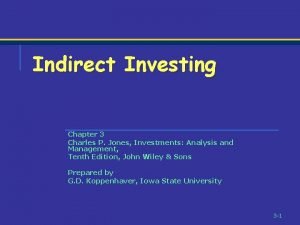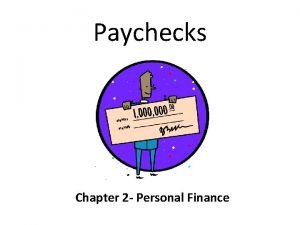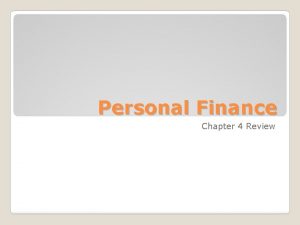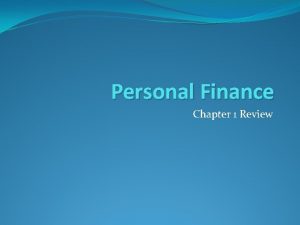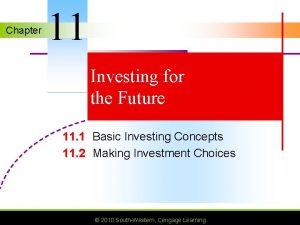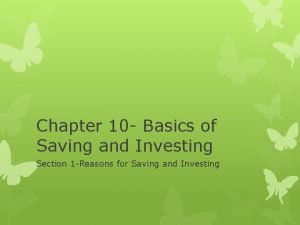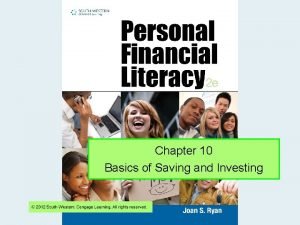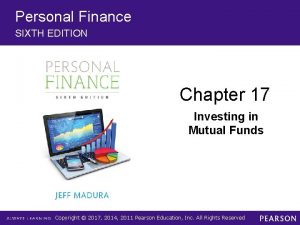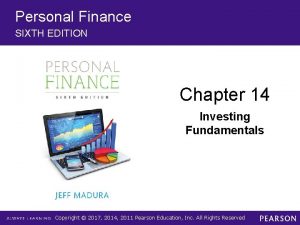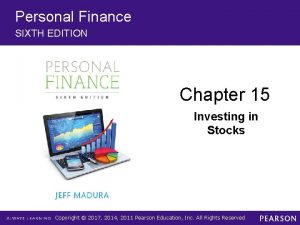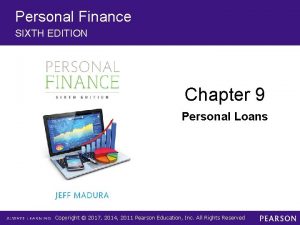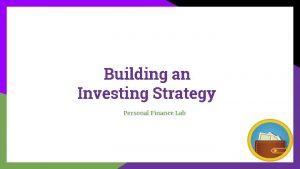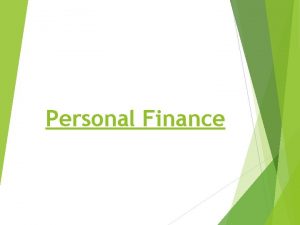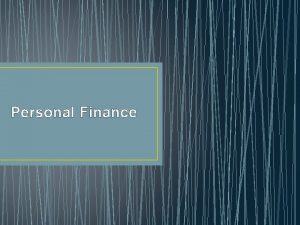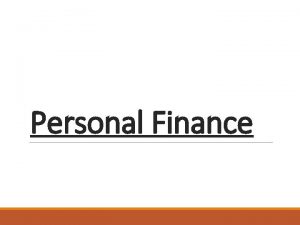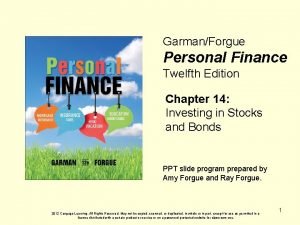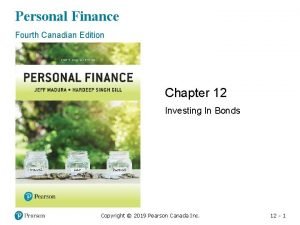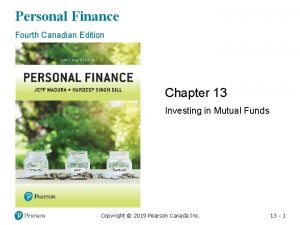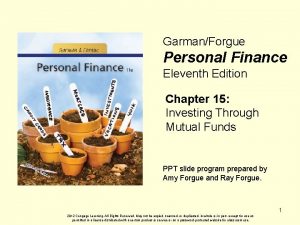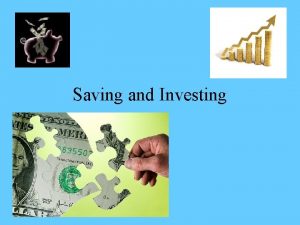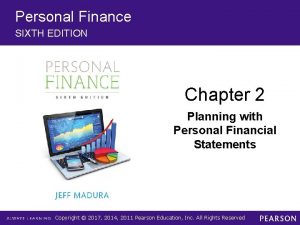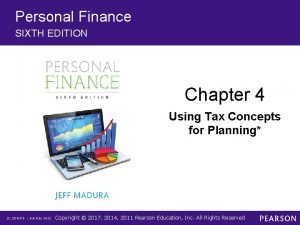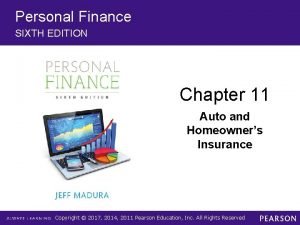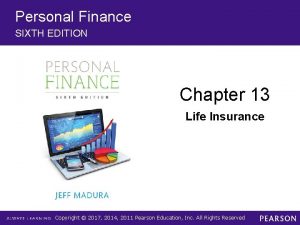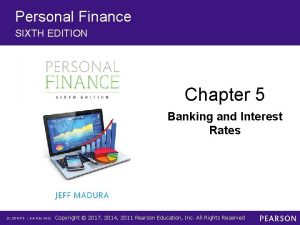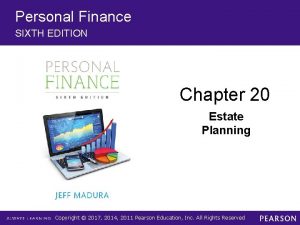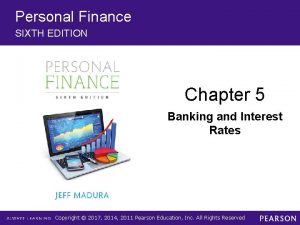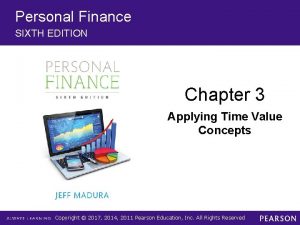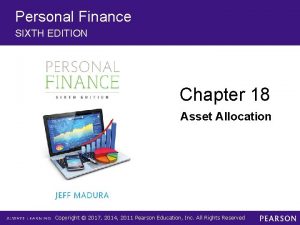Personal Finance SIXTH EDITION Chapter 16 Investing in






























- Slides: 30

Personal Finance SIXTH EDITION Chapter 16 Investing in Bonds Copyright © 2017, 2014, 2011 Pearson Education, Inc. All Rights Reserved

Chapter Objectives (1 of 2) 16. 1 Provide a background on bonds 16. 2 Identify the different types of bonds 16. 3 Identify factors that affect the return (yield) from investing in a bond 16. 4 Describe how bonds are valued 16. 5 Discuss why some bonds are risky Copyright © 2017, 2014, 2011 Pearson Education, Inc. All Rights Reserved

Chapter Objectives (2 of 2) 16. 6 Describe common bond investment strategies 16. 7 Explain how investing in bonds can fit within your financial plan Copyright © 2017, 2014, 2011 Pearson Education, Inc. All Rights Reserved

Background on Bonds (1 of 5) • Bonds: long-term debt securities issued by government agencies or corporations • Par value: for a bond, its face value, or the amount returned to the investor at the maturity date when a bond is due • Most bonds have maturities between 10– 30 years Copyright © 2017, 2014, 2011 Pearson Education, Inc. All Rights Reserved

Background on Bonds (2 of 5) • Issuers required to make interest payments and repay par value • Bond Characteristics – Call feature: a feature on a bond that allows the issuer to repurchase the bond from the investor before maturity § These bonds offer a slightly higher return Copyright © 2017, 2014, 2011 Pearson Education, Inc. All Rights Reserved

Background on Bonds (3 of 5) – Convertible bond: a bond that can be converted into a stated number of shares of the issuer’s stock if the stock price reaches a specified price § These bonds tend to offer a slightly lower return Copyright © 2017, 2014, 2011 Pearson Education, Inc. All Rights Reserved

Background on Bonds (4 of 5) • A bond’s yield to maturity: the annualized return on a bond if it is held to maturity – If a bond sells at par value, its yield to maturity equals the coupon rate – If a bond sells below par value, its yield to maturity would exceed the coupon rate – If a bond sells above par value, its yield to maturity would be less than the coupon rate Copyright © 2017, 2014, 2011 Pearson Education, Inc. All Rights Reserved

Financial Planning Online (1 of 3) • Go to http: //www. calculatorweb. com and then go to the section on bond calculators • This web site provides an estimate of the yield to maturity of your bond based on its present price, its coupon rate, and its maturity. Copyright © 2017, 2014, 2011 Pearson Education, Inc. All Rights Reserved

Background on Bonds (5 of 5) • Bond trading in the secondary market – Investors sell their bonds to other investors before they reach maturity – Bond prices change in response to interest rates – Brokerage firms also take orders to buy or sell bonds Copyright © 2017, 2014, 2011 Pearson Education, Inc. All Rights Reserved

Types of Bonds (1 of 4) • Treasury bonds: long-term debt securities issued by the U. S. Treasury – Payments guaranteed by federal government – Interest is subject to federal income tax, but exempt from state and local taxes – Can easily be sold in the secondary market Copyright © 2017, 2014, 2011 Pearson Education, Inc. All Rights Reserved

Types of Bonds (2 of 4) • Municipal bonds: long-term debt securities issued by state and local government agencies – Low risk – Interest exempt from federal income tax • Federal agency bonds: long-term debt securities issued by federal agencies – Low default risk – Interest is taxable Copyright © 2017, 2014, 2011 Pearson Education, Inc. All Rights Reserved

Financial Planning Online (2 of 3) • Go to the markets section of http: //www. bloomberg. com • This Web site provides quotations of yields offered by municipal bonds with various terms to maturity. Review this information when considering purchasing municipal bonds. Copyright © 2017, 2014, 2011 Pearson Education, Inc. All Rights Reserved

Types of Bonds (3 of 4) • Corporate bonds: long-term debt securities issued by large firms – Subject to default risk – High-yield (junk) bonds: bonds issued by smaller, less stable corporations that are subject to a higher degree of default risk Copyright © 2017, 2014, 2011 Pearson Education, Inc. All Rights Reserved

Types of Bonds (4 of 4) • Corporate bond quotations – – – Coupon rate Maturity Current yield Volume Closing price Net change in the price from the previous day Copyright © 2017, 2014, 2011 Pearson Education, Inc. All Rights Reserved

Exhibit 16. 1 An Example of Corporate Bond Quotations EXHIBIT 16. 1 An Example of Corporate Bond Quotations Company Coupon Maturity Price Yield Estimated Volume (in $1, 000 s) Zugle Co. 5. 00% Dec. 1, 2018 100. 00 5. 00% 4, 000 Copyright © 2017, 2014, 2011 Pearson Education, Inc. All Rights Reserved

Return from Investing in Bonds (1 of 3) • Impact of interest rate movements on bond returns – If interest rates rise, the value of your bond decreases – If interest rates fall, the value of your bond increases Copyright © 2017, 2014, 2011 Pearson Education, Inc. All Rights Reserved

Return from Investing in Bonds (2 of 3) • Tax implications of investing in bonds – Interest is taxed as ordinary income (unless tax exempt) – Selling bonds at a price higher than you paid also results in a capital gain Copyright © 2017, 2014, 2011 Pearson Education, Inc. All Rights Reserved

Return from Investing in Bonds (3 of 3) EXHIBIT 16. 2 Potential Tax Implications from Investing in Bonds Scenario Implication 1. You sell the bonds after eight months at a price of $9, 800. You receive one $400 coupon payment six months after buying the bond, which is taxed at your ordinary income tax rate. You also earn a short-term capital gain of $100, which is taxed at your ordinary income tax rate. 2. You sell the bonds after two years at a price of $10, 200. You receive coupon payments (taxed at your ordinary income tax rate) of $800 in the first year and in the second year. You also earn a long-term capital gain of $500 in the second year, which is subject to the long-term capital gains tax for that year. 3. You sell the bonds after two years at a price of $9, 500. You receive coupon payments (taxed at your ordinary income tax rate) of $800 in the first year and in the second year. You also incur a long-term capital loss of $200 in the second year. 4. You hold the bonds until maturity. You receive coupon payments (taxed at your ordinary income tax rate) each year over the 10 -year life of the bond. You also receive the bond’s principal of $10, 000 at the end of the 10 year period. This reflects a long-term capital gain of $300, which is subject to the long-term capital gains tax for that year. Copyright © 2017, 2014, 2011 Pearson Education, Inc. All Rights Reserved

Valuing a Bond • Uses time value of money – Present value of the future coupon payments – Present value of the principal payment • Economic impact on bond values – Higher rate of return is only realized if firms are healthy enough to make payments – This may not be true in unfavorable economic conditions Copyright © 2017, 2014, 2011 Pearson Education, Inc. All Rights Reserved

Financial Planning Online (3 of 3) • Go to the markets section of http: //www. bloomberg. com • This Web site provides a summary of recent financial news related to the bond market, which you may consider before selling or buying bonds. Copyright © 2017, 2014, 2011 Pearson Education, Inc. All Rights Reserved

Risk from Investing in Bonds (1 of 4) • Default risk: risk that the borrower of funds will not repay the creditors – Risk premium: the extra yield required by investors to compensate for the risk of default – Use of risk ratings to measure the default risk § Ratings reflect likelihood that issuers will repay their debt over time § Moody’s Investors Service, or Standard & Poor’s are two common bond rating agencies Copyright © 2017, 2014, 2011 Pearson Education, Inc. All Rights Reserved

Risk from Investing in Bonds (2 of 4) – Impact of the financial crisis on default risk § Many firms experienced financial problems and were unable to make bond payments – Relationship of risk rating to risk premium § The lower the risk rating, the higher the risk premium offered on a bond – Impact of economic conditions § Higher risk of default when economic conditions are weak Copyright © 2017, 2014, 2011 Pearson Education, Inc. All Rights Reserved

Exhibit 16. 3 Bond Rating Classes EXHIBIT 16. 3 Bond Rating Classes Risk Class Standard & Poor’s Moody’s AAA Aaa AA Aa A A BBB Baa BB Ba Low quality B B Poor quality CCC Caa CC Ca DDD C Highest quality (least risk) High quality High-medium quality Medium-low quality Very poor quality Lowest quality Copyright © 2017, 2014, 2011 Pearson Education, Inc. All Rights Reserved

Risk from Investing in Bonds (3 of 4) • Call (prepayment) risk: the risk that a callable bond will be redeemed by the issuer • Interest rate risk: the risk that a bond’s price will decline in response to an increase in interest rates – Impact of a bond’s maturity on its interest rate risk § Bonds with longer terms more sensitive to interest rate movements Copyright © 2017, 2014, 2011 Pearson Education, Inc. All Rights Reserved

Risk from Investing in Bonds (4 of 4) – Selecting an appropriate bond maturity § Choose maturities that reflect your expectations of future interest rates § Consider investing in bonds that have a maturity that matches the time you will need the funds Copyright © 2017, 2014, 2011 Pearson Education, Inc. All Rights Reserved

Bond Investment Strategies (1 of 2) • Interest rate strategy: selecting bonds for investment based on interest rate expectations – Purchase long-term bonds if you expect interest rates to fall • Passive strategy: investing in a diversified portfolio of bonds that are held for a long period of time Copyright © 2017, 2014, 2011 Pearson Education, Inc. All Rights Reserved

Bond Investment Strategies (2 of 2) • Maturity matching strategy: investing in bonds that will generate payments to match future expenses – For example, parents might invest in a bond that will mature at the right time to pay for their child’s college education Copyright © 2017, 2014, 2011 Pearson Education, Inc. All Rights Reserved

How Bond Decisions Fit within Your Financial Plan (1 of 3) • Key decisions about bonds for your financial plan are: – Should you consider buying bonds? – What strategy should you use for investing in bonds? Copyright © 2017, 2014, 2011 Pearson Education, Inc. All Rights Reserved

How Bond Decisions Fit within Your Financial Plan (2 of 3) EXHIBIT 16. 4 How Bonds Fit Within Stephanie Spratt’s Financial Plan GOALS FOR INVESTING IN BONDS 1. Determine if I could benefit from investing in bonds. 2. If I decide to invest in bonds, determine what strategy to use to invest in bonds. ANALYSIS Strategy to Invest in Bonds Opinion Interest rate strategy I cannot forecast the direction of interest rates (even experts are commonly wrong on their interest rate forecasts), so this strategy could backfire. This strategy would also complicate my tax return. Passive strategy May be appropriate for me in many situations, and the low transaction costs are appealing. Maturity matching strategy Not applicable to my situation, since I am not trying to match coupon payments to future expenses. Copyright © 2017, 2014, 2011 Pearson Education, Inc. All Rights Reserved

How Bond Decisions Fit within Your Financial Plan (3 of 3) EXHIBIT 16. 4 How Bonds Fit Within Stephanie Spratt’s Financial Plan DECISIONS Decision on Whether to Invest in Bonds: I cannot afford to buy bonds right now, but I will consider purchasing them in the future when my financial position improves. Bonds can generate a decent return, and some bonds are free from default risk. I find Treasury or AAA-rated bonds to be most attractive. Decision on the Strategy to Use for Investing in Bonds: I am not attempting to match coupon payments with future anticipated expenses. I may consider expected interest rate movements according to financial experts when I decide which bond fund to invest in, but I will not shift in and out of bond funds frequently to capitalize on expected interest rate movements. I will likely use a passive strategy of investing in bonds and will retain bond investments for a long period of time. Copyright © 2017, 2014, 2011 Pearson Education, Inc. All Rights Reserved
 Indirect investing
Indirect investing Peter pickle tongue twister
Peter pickle tongue twister The sixth sick sheik's sixth sheep's sick lyrics
The sixth sick sheik's sixth sheep's sick lyrics Personal finance 6th edition
Personal finance 6th edition Biochemistry sixth edition
Biochemistry sixth edition Computer architecture a quantitative approach sixth edition
Computer architecture a quantitative approach sixth edition Automotive technology sixth edition
Automotive technology sixth edition Automotive technology sixth edition
Automotive technology sixth edition Apa sixth edition
Apa sixth edition Computer architecture a quantitative approach 6th
Computer architecture a quantitative approach 6th Precalculus sixth edition
Precalculus sixth edition Rational people think at the margin
Rational people think at the margin Computer architecture a quantitative approach sixth edition
Computer architecture a quantitative approach sixth edition Chapter 2 personal finance
Chapter 2 personal finance Introduction to personal finance answers
Introduction to personal finance answers Chapter 8 personal finance
Chapter 8 personal finance Chapter 4 post test personal finance
Chapter 4 post test personal finance Chapter 1 post test personal finance
Chapter 1 post test personal finance Overview of personal finance chapter 1
Overview of personal finance chapter 1 Fundamentals of corporate finance 3rd canadian edition
Fundamentals of corporate finance 3rd canadian edition Corporate finance tenth edition
Corporate finance tenth edition Fundamentals of corporate finance third canadian edition
Fundamentals of corporate finance third canadian edition Fundamentals of corporate finance fifth edition
Fundamentals of corporate finance fifth edition Corporate finance 6th edition
Corporate finance 6th edition Corporate finance tenth edition
Corporate finance tenth edition Corporate finance tenth edition
Corporate finance tenth edition Corporate finance tenth edition
Corporate finance tenth edition Corporate finance tenth edition
Corporate finance tenth edition Put and take account
Put and take account Chapter 10 basics of saving and investing
Chapter 10 basics of saving and investing Holding a variety of investments to reduce risk
Holding a variety of investments to reduce risk
